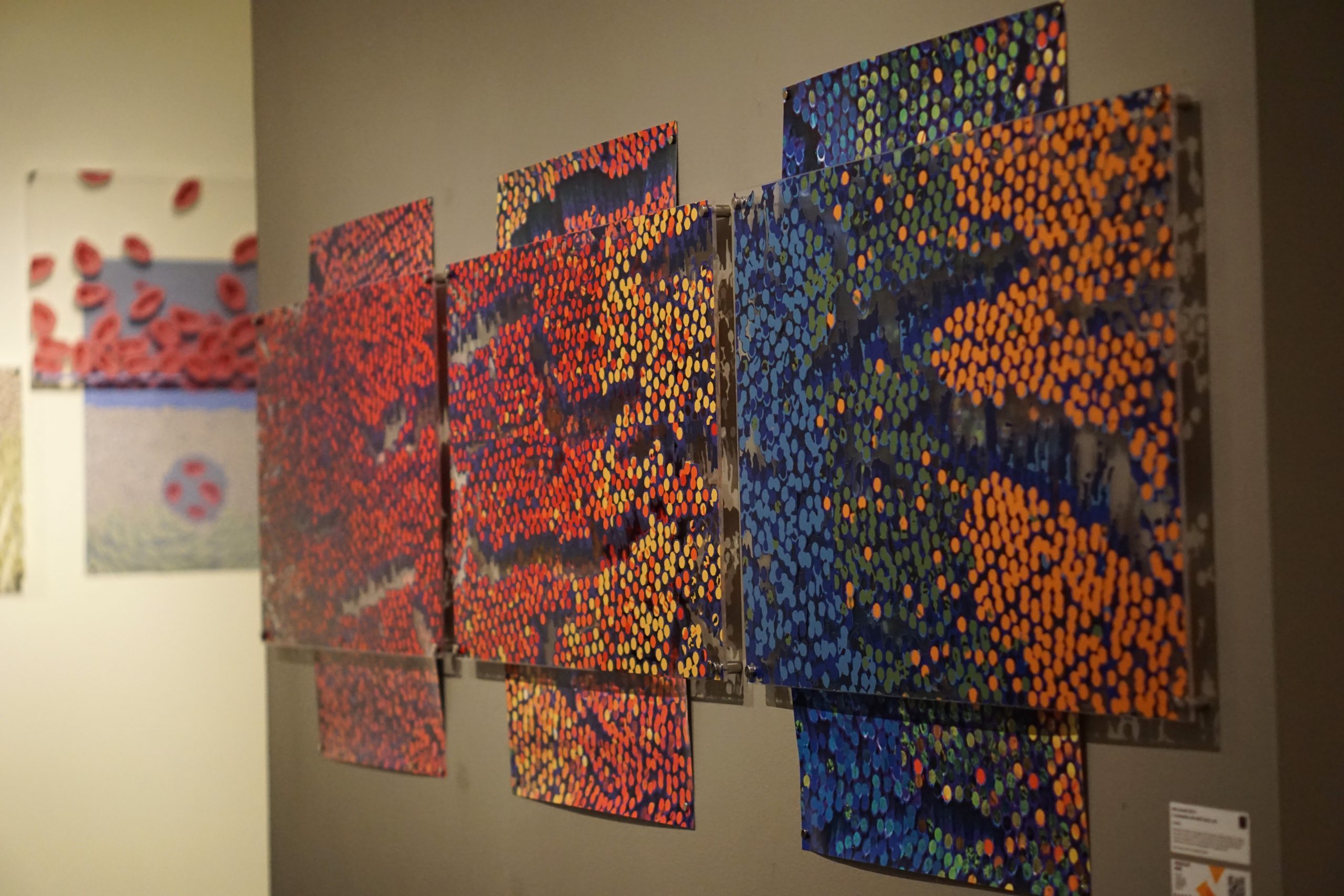Artwork created by visionary undergraduate artists from Vanderbilt and other universities is on display at the Vanderbilt Fine Arts Gallery in Cohen Memorial Hall and embedded throughout biomedical research spaces on campus. The exhibit, Molecular Muse, represents the past four years of the Vanderbilt Institute for Infection, Immunology and Inflammation Artist-in-Residence program. The show is open through Nov. 17, 2023.
Molecular Muse is curated by Rio (Xueyuan) Jia, a graduate student at the Vanderbilt Data Science Institute, Debbie Wang, BA’23, a recent biology and neuroscience student and ArtLab member, and Kendra H. Oliver, associate professor of pharmacology and ArtLab founder and director.
“Art as a form of communication has such power to challenge and expose our knowledge in ways that innovate and drive scientific discovery,” Oliver said. “The VI4 AiR program has been a tremendously successful experiment in designing opportunities for new forms of insight through science-art.”
To explore and advocate for art as an essential tool for effective science communication, ArtLab was established in 2017 as a hub for visual design and science outreach activity across Vanderbilt and Vanderbilt University Medical Center. The VI4 AiR program, one of ArtLab’s signature initiatives, was started in 2019, and it matches undergraduate artists with research laboratories each summer. The resulting works—visual representations of the institutions’ transformative research—have been included in research manuscripts and as the cover art of academic journals. Since its inception, ArtLab has engaged more than 150 students and hosted 10 virtual and in-person art exhibitions.
The works in Molecular Muse encapsulate the diversity and complexity of research, spanning topics from intricate displays of cellular architecture to the breathtaking vastness of knowledge. It is the first time all VI4 artists’ work has been shown in a gallery together.
‘Molecular Muse,’ curated by Rio (Xueyuan) Jia, Debbie Wang and Kendra H. Oliver, is a visual representation of transformative research. It showcases intricate displays of cellular architecture, the breathtaking vastness of knowledge and more.
(Photos by Caroline Cencer)
“The Molecular Muse exhibit is a wonderful demonstration of the success of the VI4 AiR program and the commitment of VI4 to identifying powerful and creative ways to communicate science to the public,” said Eric Skaar, VI4 director, vice chair for research and University Distinguished Professor of Pathology, Microbiology and Immunology. “Under Kendra Oliver’s leadership, this program is emerging as a national model for how science and art can come together to energize people about discovery.”
The show opened on Aug. 7, including presentations from this year’s VI4 AiR students and an informative session on the Burroughs Wellcome Fund by Drs. Lou Muglia and Victoria McGovern, BWF president and CEO, and senior program officer, respectively.
‘Molecular Muse’ represents the past four years of the Vanderbilt Institute for Infection, Immunology and Inflammation Artist-in-Residence program. The show is open through Nov. 17, 2023. (Photos by Caroline Cencer)
VI4 AiR is supported by the Burroughs Wellcome Fund, the Wond’ry, The Curb Center for Art, Enterprise and Public Policy, and the Communication of Science and Technology program. In addition to Oliver, the show opening was facilitated by VI4 program manager Megan Schladt and by Jen Silverman and Caroline Cencer, graduate students in the Tyska lab.
“Vanderbilt’s strength is in its potential to examine ideas through different approaches by collaborating with colleagues whose work at first glance appears disconnected from our own,” said Amanda H. Hellman, director of the Fine Arts Gallery. “The intersections we uncover are often the most meaningful, and building strong relationships means that we can also amplify these discoveries to expand our audiences. Translating scientific research into the visual language of line, form, composition, color and texture helps us understand our world around us and motivates innovative problem solving.”



































